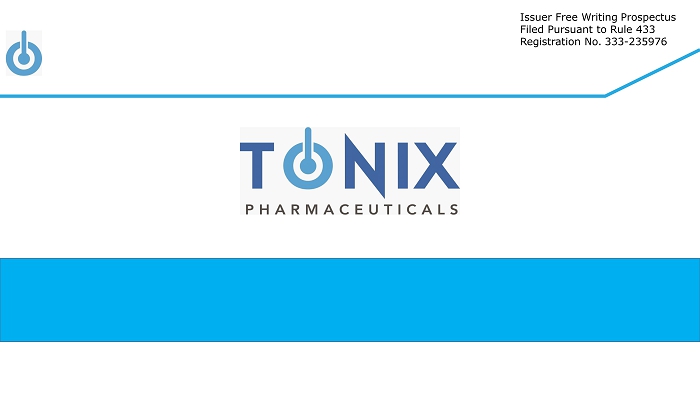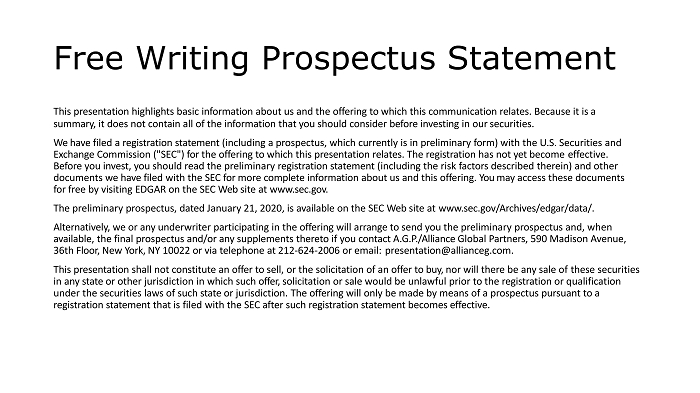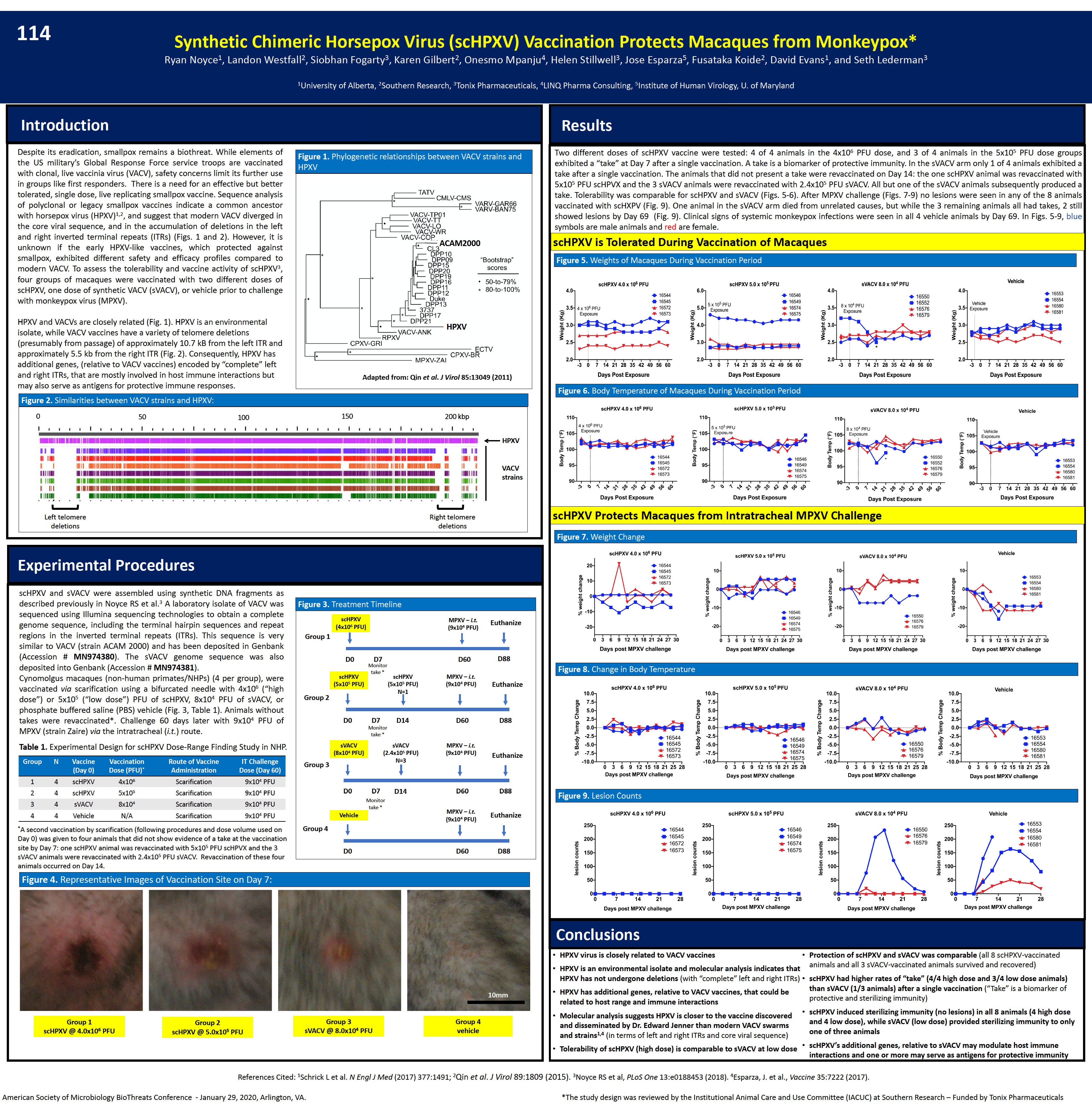

Issuer Free Writing Prospectus Filed Pursuant to Rule 433 Registration No. 333 - 235976

Cautionary Note on Forward - Looking Statements Certain statements in this presentation regarding strategic plans, expectations and objectives for future operations or results are “forward - looking statements” as defined by the Private Securities Litigation Reform Act of 1995 . These statements may be identified by the use of forward - looking words such as “anticipate,” “believe,” “forecast,” “estimate” and “intend,” among others . These forward - looking statements are based on Tonix’s current expectations and actual results could differ materially . There are a number of factors that could cause actual events to differ materially from those indicated by such forward - looking statements . These factors include, but are not limited to, substantial competition ; our need for additional financing ; uncertainties of patent protection and litigation ; uncertainties of government or third party payor reimbursement ; limited research and development efforts and dependence upon third parties ; and risks related to failure to obtain U . S . Food and Drug Administration clearances or approvals and noncompliance with its regulations . As with any pharmaceutical under development, there are significant risks in the development, regulatory approval and commercialization of new products . The forward - looking statements in this presentation are made as of the date of this presentation, even if subsequently made available by Tonix on its website or otherwise . Tonix does not undertake an obligation to update or revise any forward - looking statement, except as required by law . Investors should read the risk factors set forth in the Annual Report on Form 10 - K for the year ended December 31 , 2018 , as filed with the Securities and Exchange Commission (the “SEC”) on March 18 , 2019 , and periodic reports and current reports filed with the SEC on or after the date thereof . All of Tonix's forward - looking statements are expressly qualified by all such risk factors and other cautionary statements .

Free Writing Prospectus Statement This presentation highlights basic information about us and the offering to which this communication relates. Because it is a summary, it does not contain all of the information that you should consider before investing in our securities. We have filed a registration statement (including a prospectus, which currently is in preliminary form) with the U.S. Securities and Exchange Commission ("SEC") for the offering to which this presentation relates. The registration has not yet become effective. Before you invest, you should read the preliminary registration statement (including the risk factors described therein) and other documents we have filed with the SEC for more complete information about us and this offering. You may access these documents for free by visiting EDGAR on the SEC Web site at www.sec.gov. The preliminary prospectus, dated January 21, 2020, is available on the SEC Web site at www.sec.gov/Archives/edgar/data/. Alternatively, we or any underwriter participating in the offering will arrange to send you the preliminary prospectus and, when available, the final prospectus and/or any supplements thereto if you contact A.G.P./Alliance Global Partners, 590 Madison Avenue, 36th Floor, New York, NY 10022 or via telephone at 212 - 624 - 2006 or email: p resentation@allianceg.com. This presentation shall not constitute an offer to sell, or the solicitation of an offer to buy, nor will there be any sale of these securities in any state or other jurisdiction in which such offer, solicitation or sale would be unlawful prior to the registration or qualification under the securities laws of such state or jurisdiction. The offering will only be made by means of a prospectus pursuant to a registration statement that is filed with the SEC after such registration statement becomes effective.
 a
a
114Synthetic Chimeric Horsepox Virus (scHPXV) Vaccination Protects Macaques from Monkeypox* Ryan Noyce1, Landon Westfall2, Siobhan Fogarty3, Karen Gilbert2, Onesmo Mpanju4, Helen Stillwell3, Jose Esparza5, Fusataka Koide2, David Evans1, and Seth Lederman31University of Alberta, 2Southern Research, 3Tonix Pharmaceuticals, 4LINQ Pharma Consulting, 5Institute of Human Virology, U. of MarylandIntroductionDespite its eradication, smallpox remains a biothreat. While elements of the US military’s Global Response Force service troops are vaccinated with clonal, live vaccinia virus (VACV), safety concerns limit its further use in groups like first responders. There is a need for an effective but better tolerated, single dose, live replicating smallpox vaccine. Sequence analysis of polyclonal or legacy smallpox vaccines indicate a common ancestor with horsepox virus (HPXV)1,2, and suggest that modern VACV diverged in the core viral sequence, and in the accumulation of deletions in the left and right inverted terminal repeats (ITRs) (Figs. 1 and 2). However, it is unknown if the early HPXV-like vaccines, which protected against smallpox, exhibited different safety and efficacy profiles compared to modern VACV. To assess the tolerability and vaccine activity of scHPXV3, four groups of macaques were vaccinated with two different doses of scHPXV, one dose of synthetic VACV (sVACV), or vehicle prior to challenge with monkeypox virus (MPXV).HPXV and VACVs are closely related (Fig. 1). HPXV is an environmental isolate, while VACV vaccines have a variety of telomere deletions (presumably from passage) of approximately 10.7 kB from the left ITR and approximately 5.5 kb from the right ITR (Fig. 2). Consequently, HPXV has additional genes, (relative to VACV vaccines) encoded by “complete” left and right ITRs, that are mostly involved in host immune interactions but may also serve as antigens for protective immune responses.Figure 1. Phylogenetic relationships between VACV strains and HPXVACAM2000HPXVAdapted from: Qin et al. J Virol 85:13049 (2011)Figure 2. Similarities between VACV strains and HPXV: 0Left telomere deletions 50 100 150 200 kbpRight telomere deletions HPXV VACV strainsExperimental Procedures scHPXV and sVACV were assembled using synthetic DNA fragments as described previously in Noyce RS et al.3 A laboratory isolate of VACV was sequenced using Illumina sequencing technologies to obtain a complete genome sequence, including the terminal hairpin sequences and repeat regions in the inverted terminal repeats (ITRs). This sequence is very similar to VACV (strain ACAM 2000) and has been deposited in Genbank (Accession # MN974380). The sVACV genome sequence was also deposited into Genbank (Accession # MN974381). Cynomolgus macaques (non-human primates/NHPs) (4 per group), were vaccinated via scarification using a bifurcated needle with 4x106 (“high dose”) or 5x105 (“low dose”) PFU of scHPXV, 8x104 PFU of sVACV, or phosphate buffered saline (PBS) vehicle (Fig. 3, Table 1). Animals without takes were revaccinated*. Challenge 60 days later with 9x104 PFU of MPXV (strain Zaire) via the intratracheal (i.t.) route. Table 1. Experimental Design for scHPXV Dose-Range Finding Study in NHP.2 4 scHPXV 5x105 Scarification 9x104 PFU 3 4 sVACV 8x104 Scarification 9x104 PFU 4 4 Vehicle N/A Scarification 9x104 PFU *A second vaccination by scarification (following procedures and dose volume used on Day 0) was given to four animals that did not show evidence of a take at the vaccination site by Day 7: one scHPXV animal was revaccinated with 5x105 PFU scHPVX and the 3 sVACV animals were revaccinated with 2.4x105 PFU sVACV. Revaccination of these four animals occurred on Day 14. Figure 4. Representative Images of Vaccination Site on Day 7:Group 1 Group 2 scHPXV @ 4.0x106 PFU scHPXV @ 5.0x105 PFU Figure 3. Treatment Timeline scHPXV (4x106 PFU) Group 1D0 D7 Monitor take * scHPXV scHPXV (5x105 PFU) (5x105 PFU) N=1 Group 2D0 D7 D14 Monitor take * sVACV sVACV (8x104 PFU) (2.4x105 PFU) Group 3 N=3D0 D7 D14 Monitor take * Vehicle Group 4D0Group 3 sVACV @ 8.0x104 PFUMPXV – i.t. (9x104 PFU)D60MPXV – i.t. (9x104 PFU)D60MPXV – i.t. (9x104 PFU)D60MPXV – i.t. (9x104 PFU)D60Group 4 vehicleEuthanizeD88EuthanizeD88EuthanizeD88EuthanizeD8810mmReferences Cited: 1Schrick L et al. N Engl J Med (2017) 377:1491; 2Qin et al. J Virol 89:1809 (2015). 3Noyce RS et al, PLoS One 13:e0188453 (2018). 4Esparza, J. et al., Vaccine 35:7222 (2017).American Society of Microbiology BioThreats Conference - January 29, 2020, Arlington, VA. *The study design was reviewed by the Institutional Animal Care and Use Committee (IACUC) at Southern Research – Funded by Tonix Pharmaceuticals